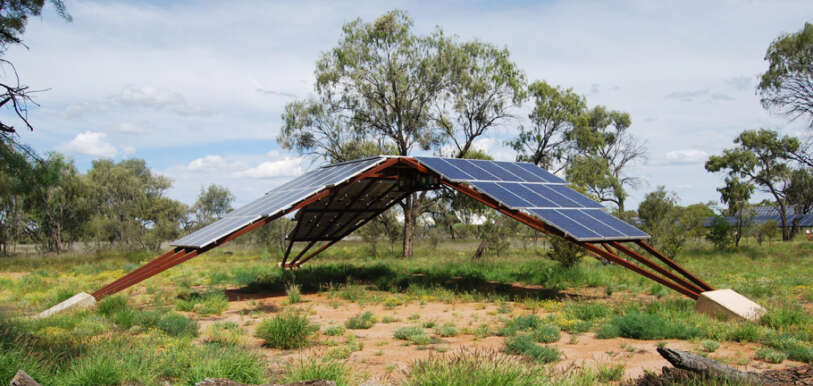| Manufacturer | BP Solar |
|---|---|
| Array Rating | 1.98kW |
| PV Technology | poly-Si |
| Array Structure | Fixed: Ground Mount |
| Installed | 2008 |
View on Map Graphs Download Data
Current Output

Fixed polycrystalline silicon arrays oriented east, west, north and flat.
Orienting a solar array due north in the southern hemisphere will maximise its exposure to the sun through the day, on most days of the year. Where a north installation is not possible, arrays might be installed facing the east or west. "Flat" installations are usually avoided, because their surface is more susceptible to dust buildup and soiling.
This solar compass will quantify the impact of installing an array facing east, west or flat, as opposed to the ideal north facing position. Identical 2 kW polycrystalline BP arrays have been installed on a purpose-built frame.
Arrays oriented east or west will receive the same amount of sunlight through the year. In terms of the power they produce, however, there are different benefits associated with either direction.
East-facing arrays receive light in the morning, when temperatures are cooler and the solar panels are operating more efficiently. West-facing arrays receive their light in the afternoon, when the higher temperatures are associated with the day’s peak air-conditioning demand.
The solar compass will contribute meaningful comparative data to the assessment of these relative benefits.
BP Solar is a global business that designs, manufactures and markets solar electricity systems.
| Array Rating | 1.98kW |
|---|---|
| Panel Rating | 165W |
| Number Of Panels | 12 |
| Panel Type | BP 3165J |
| Array Area | 15.1 m² |
| Type Of Tracker | N/A |
| Inverter Size / Type | 2.5 kW, SMA SB 2500 |
| Installation Completed | Tue, 11 Nov 2008 |
| Array Tilt/Azimuth | Tilt = 2, Azi = 0 (Solar North) |

Notes on the Data
-
System Disconnection for Cabling Works
All arrays at the Solar Centre were disconnected from approximately 2.00pm to 3.00pm on Monday, 9 July 2018 in preparation for the cable between the main switchboard and distribution board being upgraded. Array sites #23-38 remained disconnected while the main feeder cable to these sites was replaced in subsequent days, but all systems were re-connected by early afternoon on Thursday, 12 July 2018.
-
Monitoring Interruption for UPS Battery Replacement
The disconnection and re-connection of the solar arrays and weather station equipment while a new site connection was being established prompted the already flattening UPS batteries which power the site’s energy meters to fail and require immediate replacement. Data recording was affected from approximately 2.30pm ACST, Monday 10 July to 4.00pm, Wednesday 12 July.
Affects weather data for DKASC, Alice Springs
> Answer to Spotlight Question
Onsite at the DKA Solar Centre in Alice Springs are a series of quiz-like Spotlight Questions at each array. Visit the centre and scan the QR code at each sign to test your knowledge – and check your answer here!
Q: If a solar array is facing east, would you expect it to generate more or less energy in the morning, compared to an array facing west?
A: A solar array facing east can be expected to generate more energy in the morning compared to an array that faces west, because the sun rises in the east and travels across the sky heading west throughout the day. An array facing towards east is therefore better positioned to capture the morning sunlight, except possibly at a site where the morning is commonly cloudy or foggy and the sun does not make an effective appearance until later in the day.
